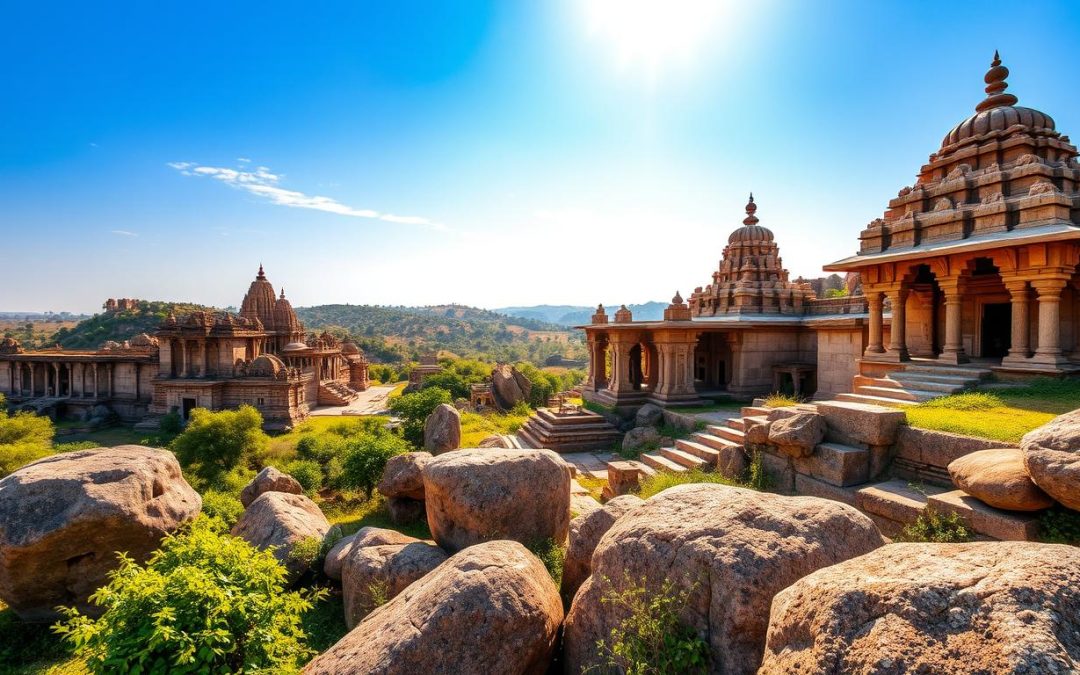Have you ever wondered about the secrets hidden in ancient India’s rocky landscapes? Hampi, a UNESCO World Heritage Site, invites you to explore its mix of history and stunning views.
In Karnataka, Hampi covers 42 square kilometers. It has over 1,500 heritage sites that tell tales of the Vijayanagara Empire. Your visit will take you back in time, showing you amazing buildings, spiritual places, and cultural gems.
Hampi is a treasure trove for history buffs, adventure lovers, and culture seekers. Every stone and monument here shares a piece of India’s architectural and historical past.
Key Takeaways
- Explore over 1,500 historical structures across 42 square kilometers
- Discover the UNESCO World Heritage Site with unique architectural wonders
- Experience the rich cultural heritage of the Vijayanagara Empire
- Witness ancient temples and historical landscapes
- Immerse yourself in a destination that blends history, spirituality, and natural beauty
Exploring the UNESCO World Heritage Site of Hampi
Hampi, in Karnataka’s rocky landscape, is a stunning reminder of the Ancient Vijayanagara Empire. This UNESCO World Heritage Site takes you back through centuries of history. Every stone and structure shares a story of architectural and cultural greatness.
Understanding the Historical Significance
The Ruins of Hampi were the last great Hindu kingdom in South India. They existed from 1336 to 1565 CE. Exploring this place, you’ll see a civilization that was advanced, powerful, and full of art.
- Capital of the Vijayanagara Empire for over 200 years
- Contains more than 1,600 surviving architectural remains
- Showcases remarkable Hindu architectural and cultural achievements
Archaeological Importance
Hampi is like an open-air museum that shows us medieval South Indian life. Its treasures give us a peek into society, art, and technology back then.
“In Hampi, every stone whispers stories of a magnificent past waiting to be understood.” – Archaeological Survey of India
Cultural Heritage Overview
Hampi’s culture is more than just buildings. It’s a lively civilization with detailed temples, royal areas, and smart city planning.
- Intricate temple carvings depicting mythological narratives
- Advanced water management systems
- Rich artistic traditions preserved in stone and sculpture
Walking through Hampi, you’ll see the lasting impact of the Ancient Vijayanagara Empire. It shows us the power of human creativity and cultural strength.
Virupaksha Temple: The Living Heritage
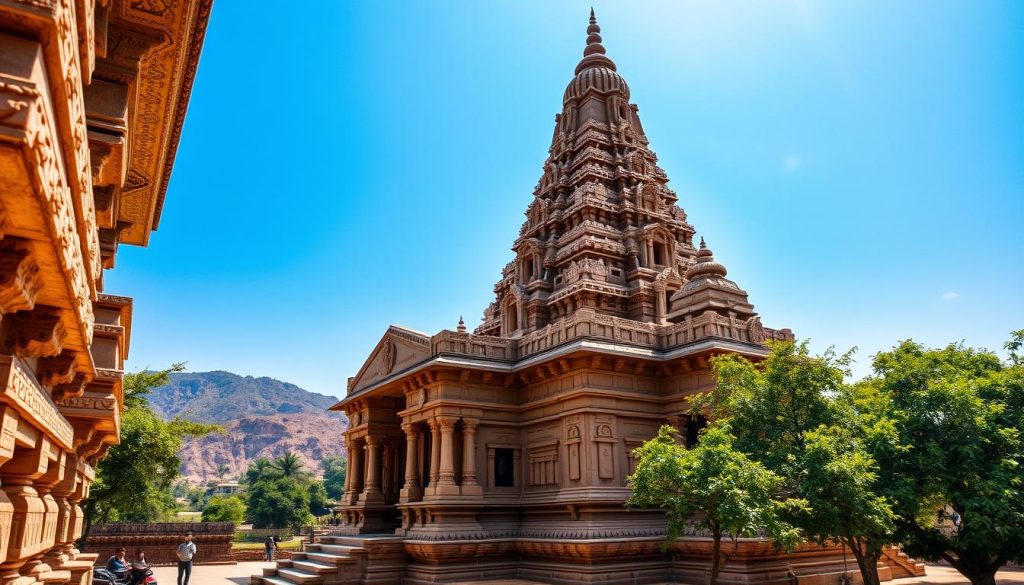
Step into the heart of Hampi’s ancient wonders at the Virupaksha Temple. This architectural marvel has stood the test of time. Dating back to the 7th century, it’s one of the oldest functioning religious sites in India.
The temple’s gopuram (gateway tower) rises dramatically against the sky. It stretches nearly 50 meters high with nine intricate tiers. Since 1986, it has been a UNESCO World Heritage Site, showing the rich cultural heritage of the Vijayanagara Empire.
- Continuous functioning since 7th century CE
- Nine-tiered gopuram reaching 50 meters high
- UNESCO World Heritage Site
- Active place of worship with daily rituals
Visitors can see fascinating daily traditions. There’s even a temple elephant named Lakshmi who participates in blessings. The temple complex has a unique underwater Shiva shrine that becomes submerged during the monsoon season.
*”A journey through Virupaksha Temple is a journey through time itself.”*
The best time to explore this site is between November and February. The weather is most favorable then. Archaeological experts from the Archaeological Survey of India work to preserve this monument. They ensure its spiritual and historical significance remains for future generations.
Vittala Temple Complex and Stone Chariot
The Vittala Temple is in the heart of Hampi. It shows the amazing skills of the Vijayanagara builders. This place is full of beauty and history.
The Vittala Temple is famous for its unique features. It has 56 stone-carved pillars. These pillars show the amazing engineering of medieval India.
Musical Pillars Experience
The Vittala Temple is known for its musical pillars. These pillars make different sounds when tapped. It’s a wonder that has amazed people for years.
Architectural Marvel of Stone Chariot
The Stone Chariot is a symbol of Vijayanagara’s skill. It’s a big sculpture carved from one rock. It looks so real, thanks to the ancient artisans.
- Constructed in the 16th century
- Symbolizes celestial transportation
- Considered a masterpiece of stone sculpture
Best Time to Visit
Visit the Vittala Temple from November to March for the best weather. Early morning or late afternoon is perfect for photos. You’ll feel the temple’s calm.
“The Vittala Temple is not just a monument, but a symphony carved in stone.” – Archaeological Survey of India
Exploring the Vittala Temple is a must in Hampi. It shows the rich culture and architecture of the Vijayanagara Empire.
Royal Enclosures and Palace Ruins
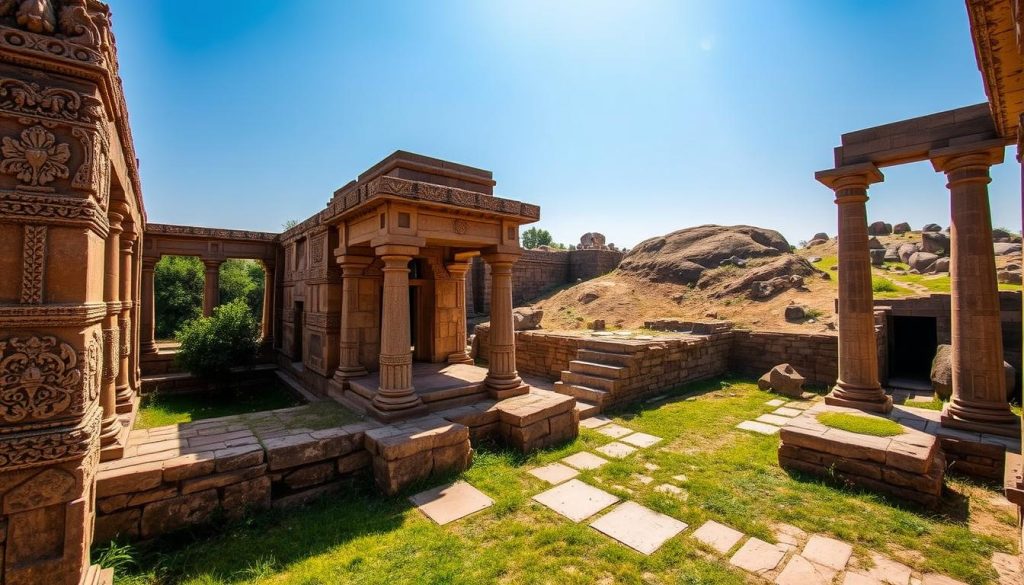
Step into the heart of the Ruins of Hampi and discover the magnificent Royal Enclosures. These were the nerve centers of the Ancient Vijayanagara Empire. They offer a glimpse into the sophisticated urban planning and royal lifestyle of one of India’s most powerful kingdoms.
The Royal Center spans an impressive area. It reveals the grandeur of Vijayanagara’s rulers through several remarkable structures:
- Mahanavami Dibba: A massive pyramidal platform used for royal ceremonies
- Queen’s Bath: An ornate structure showcasing royal luxury
- Elephant Stables: Impressive chambers highlighting the importance of royal processions
Key highlights of the Royal Enclosures include:
| Structure | Significance | Notable Feature |
|---|---|---|
| Mahanavami Dibba | Royal Platform | Tallest structure in the enclosure |
| Queen’s Bath | Royal Wellness Area | Central pond with surrounding verandas |
| Elephant Stables | Royal Transportation | Domed chambers for royal elephants |
“The Royal Enclosures of Hampi are a testament to the architectural brilliance and cultural sophistication of the Vijayanagara Empire.” – Archaeological Experts
Your exploration of the Ruins of Hampi will reveal intricate details of a civilization that once dominated South Indian history. The Royal Enclosures stretch approximately 2 kilometers from Hampi Bazaar. They offer visitors an immersive journey through the Ancient Vijayanagara Empire’s most intimate spaces.
Pro Tip: Plan to spend at least 4-5 hours exploring these magnificent ruins. This will help you truly appreciate their historical significance and architectural marvel.
Sacred Landscapes and Temple Architecture
Hampi’s spiritual landscape is filled with ancient temples that take you back centuries. The rocky terrain is a backdrop for amazing religious structures. These structures show the artistic and cultural richness of the Vijayanagara Empire.
Exploring Hampi’s sacred sites reveals architectural wonders. These wonders blend spiritual importance with artistic skill. Let’s look at three temple complexes that capture the spiritual essence of this UNESCO World Heritage Site.
Hemakuta Hill Complex: A Spiritual Panorama
The Hemakuta Hill Complex is a journey through architectural history. It spans from the 9th to 14th centuries. This site offers:
- Panoramic views of Hampi’s landscape
- Multiple shrines dedicated to Lord Shiva
- Unique architectural features representing different historical periods
Sasivekalu Ganesha Temple: Monolithic Marvel
The Sasivekalu Ganesha Temple features a stunning 2.4-meter statue of Lord Ganesha. It’s carved from a single boulder. This shows the amazing sculpting skills of Vijayanagara artisans.
Lakshmi Narasimha Temple: Divine Magnitude
The Lakshmi Narasimha Temple is a showcase of spiritual artistry. It has an impressive statue of Narasimha (Vishnu’s man-lion avatar) on cosmic serpent Adishesha. This represents divine power and intricate craftsmanship.
“In every stone of Hampi, there’s a story waiting to be discovered” – Local Historian
| Temple | Key Feature | Historical Period |
|---|---|---|
| Hemakuta Hill Complex | Multiple Shiva Shrines | 9th-14th Century |
| Sasivekalu Ganesha Temple | 2.4m Monolithic Statue | 15th Century |
| Lakshmi Narasimha Temple | Narasimha Avatar Statue | 15th Century |
These temples show religious devotion and artistic expression from the Vijayanagara period. Each site has a unique story of spiritual dedication and architectural brilliance.
Tungabhadra River Adventures
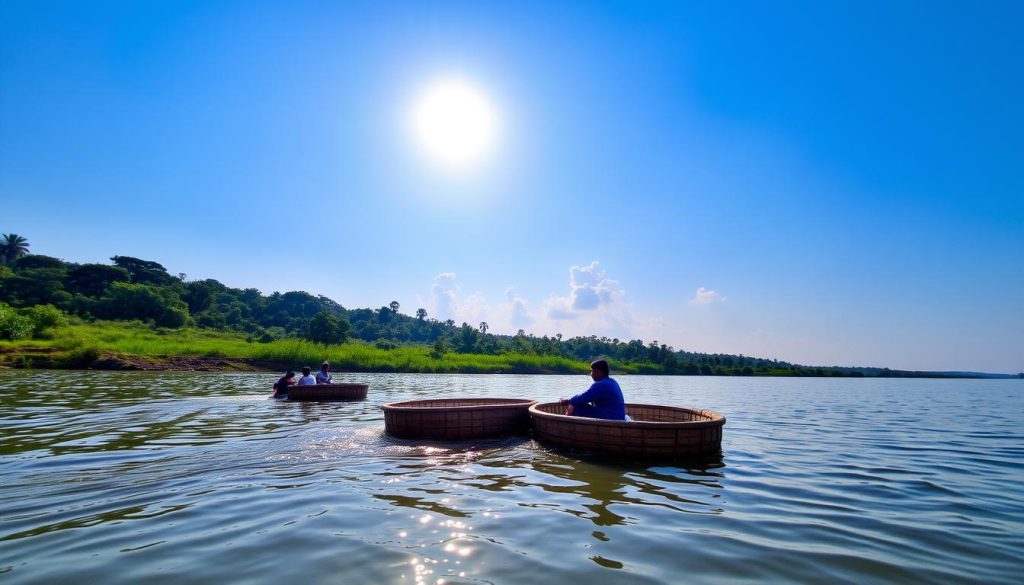
Leave the temple trails behind and explore the Tungabhadra River. The Tungabhadra River Coracle Ride is a unique way to see Hampi’s stunning views. It offers a fresh perspective on the breathtaking landscape.
Traditional coracle boats, made from bamboo and grass, have been used here for centuries. These boats can hold 6 to 8 people. They offer a close-up look at Hampi’s beautiful river area.
“A coracle ride is not just a boat trip, but a journey through time and tradition”
- Experience stunning views of boulder-strewn hills
- Explore riverside ruins from a unique vantage point
- Watch for ancient carvings along the riverbanks
- Enjoy opportunities for cliff jumping in designated areas
For the best experience, take the Tungabhadra River Coracle Ride at sunset. The golden light makes the ancient ruins glow. It’s a moment you’ll never forget.
Pro tip: Wear comfy clothes and bring a waterproof camera. You’ll want to capture the beautiful scenery on your river adventure.
Anegundi Village and Local Culture
Anegundi Village is across the Tungabhadra River. It gives travelers a peek into rural Karnataka’s rich culture. This old settlement is older than Hampi and is linked to the Ramayana.
Traditional Crafts and Artisans
Anegundi Village is a living museum of traditional crafts. Local artisans keep old skills alive. You’ll see amazing crafts like:
- Banana fiber weaving
- Natural dyeing techniques
- Handloom textile production
- Clay pottery making
Cultural Experiences
Dive into Anegundi’s authentic rural life. The village lets you connect with local traditions through:
- Traditional workshops
- Folk music performances
- Local festival celebrations
- Meeting community artisans
“Anegundi is not just a village, it’s a living narrative of Karnataka’s cultural heritage.” – Local Cultural Historian
Local Food Specialties
Your food journey in Anegundi Village will show you organic, farm-fresh dishes. These dishes reflect the area’s farming traditions.
| Local Dish | Key Ingredients | Flavor Profile |
|---|---|---|
| Jowar Roti | Sorghum flour | Earthy, nutritious |
| Brinjal Curry | Local eggplants, spices | Spicy, aromatic |
| Traditional Sweets | Local grains, jaggery | Sweet, wholesome |
Visiting Anegundi Village gives you a real experience. It adds to the history of nearby Hampi. It shows the living traditions of the region.
Sunset and Sunrise Viewpoints
Exploring Hampi’s best things to do isn’t complete without experiencing its breathtaking sunset and sunrise locations. The ancient landscape provides extraordinary vantage points that transform ordinary moments into magical memories.
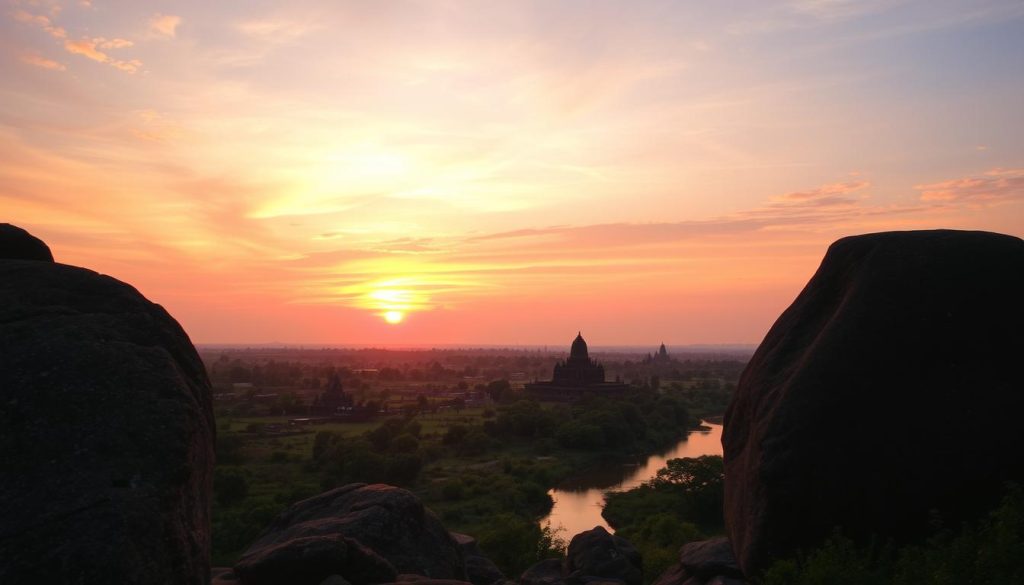
Hampi offers several remarkable spots for capturing the day’s most beautiful transitions. Here are the top sunset and sunrise locations you shouldn’t miss:
- Matanga Hill: Recognized as the premier sunset viewing location in Hampi
- Anjanadri Hill: Legendary birthplace of Hanuman with stunning panoramic views
- Hemakuta Hill: Scenic vista featuring historical Vijayanagara empire ruins
- Sunset Point at Hippie Island: Vibrant atmosphere with potential live music experiences
“Watching the sun paint the ancient rocks of Hampi is like witnessing history come alive through light and shadow.”
For the most memorable experience, plan your visit during the golden hours. Bring comfortable walking shoes, a camera, and plenty of water. Safety tip: Always use a flashlight during dawn or dusk hikes and stick to marked paths.
| Location | Best Time | Key Features |
|---|---|---|
| Matanga Hill | Sunrise/Sunset | Panoramic archaeological landscape |
| Anjanadri Hill | Sunrise | Mythological significance |
| Hemakuta Hill | Sunset | Historical temple ruins |
| Sunset Point | Sunset | Social atmosphere |
Remember, Hampi’s best things to do include capturing these magical moments that connect you with the region’s rich historical and natural beauty. Each viewpoint offers a unique perspective on this UNESCO World Heritage Site.
Mythological Connection: Ramayana Circuit
Step into a world where myths and history blend in the Ancient Vijayanagara Empire. Hampi is more than ancient ruins; it’s a canvas of the Ramayana. Your trip here connects you to the stories of Lord Rama and his loyal friends.
The area around Hampi is thought to be Kishkindha, the kingdom of monkey gods from the Ramayana. Each spot here tells of brave deeds and divine help.
- Anjaneya Hill: Birthplace of Hanuman, the monkey god and Rama’s most loyal ally
- Anjanadri Hill: Cave where Sugriva reportedly hid Sita’s jewels
- Pampa Sarovar: Sacred tank where Rama met Shabari, a devoted follower
“Walking through Hampi is like stepping into the pages of the Ramayana” – Local Mythological Guide
Hampi’s ruins come alive with mythological tales. You’ll see places that mix legend and truth, showing the spirit of the Ancient Vijayanagara Empire.
| Mythological Site | Key Ramayana Connection |
|---|---|
| Anjaneya Hill | Hanuman’s Birthplace |
| Pampa Sarovar | Rama and Shabari’s Meeting |
| Anjanadri Hill | Sugriva’s Secret Cave |
Exploring Hampi shows that myths are alive, not just old stories. They still inspire and draw visitors from everywhere.
Hidden Gems and Lesser-Known Spots
Beyond Hampi’s famous sites, a world of wonders waits for the adventurous. These hidden spots offer unique experiences beyond the usual tourist paths. They show the area’s rich history and natural beauty.
Daroji Bear Sanctuary: A Wildlife Sanctuary
The Daroji Bear Sanctuary is a unique wildlife spot covering 82.72 square kilometers. It’s a rare chance to see Indian sloth bears in the wild. It’s Asia’s first sloth bear sanctuary, just 15 kilometers from Hampi.
- Open daily from 6:00 AM to 6:00 PM
- Home to numerous sloth bear populations
- Excellent spot for wildlife photography
- Guided safari experiences available
Underground Shiva Temple: A Hidden Archaeological Marvel
The Prasanna Virupaksha Temple, known as the Underground Shiva Temple, is a remarkable find. Dating back to the 14th century, it was hidden for over 400 years. Walking through its underground chambers is like stepping back in time.
“Each stone in the Underground Shiva Temple whispers stories of forgotten civilizations.”
Ancient Rock Art Sites: Prehistoric Narratives
Hampi’s areas have fascinating prehistoric sites like Hirebenkal. It has about 400 megalithic funerary monuments. These ancient rock art sites give us a peek into human history from the Neolithic to the Iron Age.
| Site | Historical Significance | Estimated Age |
|---|---|---|
| Hirebenkal | Megalithic Funerary Monuments | Neolithic to Iron Age |
| Underground Shiva Temple | Subterranean Archaeological Site | 14th Century |
| Daroji Bear Sanctuary | Wildlife Conservation Area | Modern Conservation Site |
Exploring these lesser-known spots gives a deeper look at Hampi’s heritage. Your journey through these hidden gems uncovers history, wildlife, and culture often missed by tourists.
Practical Travel Tips for Hampi
Planning your trip to Hampi needs careful thought for a memorable journey. This UNESCO World Heritage Site is a treasure trove of history and culture.
Timing is key when exploring Hampi. The best time to visit is from November to March. The weather is cool, and there are more tourists.
Essential Travel Recommendations
- Carry enough cash since many places don’t take cards
- Wear comfy shoes for walking around sites
- Dress lightly and modestly to respect local culture
- Drink plenty of water and protect your skin from the sun
Transportation Insights
Getting around Hampi is part of the fun. You can use:
| Transport Mode | Cost Estimate | Recommended For |
|---|---|---|
| Local Rickshaw | Rs 1,200 per day | Comprehensive site tours |
| Bicycle Rental | Rs 100-200 per day | Independent exploration |
| Bus from Hospet | Rs 50-100 | Budget travelers |
“Travel light, but carry memories heavy” – Anonymous Traveler
There are many places to stay, from cheap homestays to mid-range hotels. Clarks Inn Hampi has rooms for Rs 2,000 to Rs 5,000. Book early because it’s very popular.
Hampi’s terrain is tough, so get ready for a great adventure. It’s a journey through India’s rich history.
Conclusion
Your journey through Hampi, a UNESCO World Heritage Site, is unforgettable. It’s a place where history comes alive in every stone. The Ruins of Hampi offer a deep connection to India’s culture.
From the Stone Chariot at Vittala Temple to Matanga Hill’s views, each moment is filled with wonder. You’ll see architectural and historical marvels at every turn.
Walking through Hampi’s ancient paths, you find more than just old stones. It’s a gateway to the Vijayanagara Empire’s vibrant past. You’ll see the Virupaksha Temple’s 7th-century beauty and the Hampi Bazaar’s charm.
Every step here tells a story of art and culture. It’s a journey that goes beyond just seeing sights.
Hampi is a treasure for history lovers, photographers, and adventurers. You’ll find hidden spots like the Underground Shiva Temple and the Tungabhadra River. The site’s cultural pulse is still alive today.
Get ready to be enchanted by Hampi’s timeless beauty. The Ruins of Hampi are more than a place; they’re a journey through time. Your visit will spark your imagination and create lasting memories.
The above is subject to change.
Check back often to TRAVEL.COM for the latest travel tips and deals.
